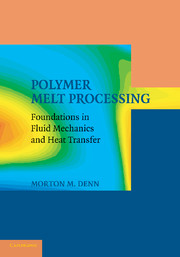Book contents
- Frontmatter
- Contents
- Preface
- 1 Polymer Processing
- 2 Fundamentals
- 3 Extrusion
- 4 Temperature and Pressure Effects in Flow
- 5 The Thin Gap Approximation
- 6 Quasi-Steady Analysis of Mold Filling
- 7 Fiber Spinning
- 8 Numerical Simulation
- 9 Polymer Melt Rheology
- 10 Viscoelasticity in Processing Flows
- 11 Stability and Sensitivity
- 12 Wall Slip and Extrusion Instabilities
- 13 Structured Fluids
- 14 Mixing and Dispersion
- Postface
- Author Index
- Subject Index
- Plate section
- References
9 - Polymer Melt Rheology
Published online by Cambridge University Press: 05 June 2012
- Frontmatter
- Contents
- Preface
- 1 Polymer Processing
- 2 Fundamentals
- 3 Extrusion
- 4 Temperature and Pressure Effects in Flow
- 5 The Thin Gap Approximation
- 6 Quasi-Steady Analysis of Mold Filling
- 7 Fiber Spinning
- 8 Numerical Simulation
- 9 Polymer Melt Rheology
- 10 Viscoelasticity in Processing Flows
- 11 Stability and Sensitivity
- 12 Wall Slip and Extrusion Instabilities
- 13 Structured Fluids
- 14 Mixing and Dispersion
- Postface
- Author Index
- Subject Index
- Plate section
- References
Summary
Introduction
Our analysis of polymer melt processing operations has thus far assumed that the polymer melt can be described as an inelastic liquid, and in fact we have generally assumed for simplicity that the melt is Newtonian. An inelastic liquid has no memory; that is, the stress in the fluid at a given time and place depends only on the deformation rate at that time and place. Entangled polymers should have memory, since the response to a deformation must depend on the reorganization of the entangled macromolecules, which cannot be instantaneous. We saw a manifestation of such memory in Figure 1.8, where a silicone polymer being squeezed between two plates under constant force “bounced,” causing transient increases in the gap spacing. Another way to think about memory is to imagine the polymer melt at rest, with the chains forming an entangled network. The chains cannot respond instantaneously if we attempt to deform the melt rapidly because they are entangled, so the initial short-time response must be that of a rubberlike network, not a viscous fluid, including shape recovery if the stress causing the deformation is quickly removed. In general, we expect to see a superposition of two responses: the short-time rubberlike response caused by deformation of the entangled network and the long-time viscous response caused by the dissipative process of relative chain motion in the flowing melt. Hence, polymer melts are viscoelastic liquids.
- Type
- Chapter
- Information
- Polymer Melt ProcessingFoundations in Fluid Mechanics and Heat Transfer, pp. 126 - 152Publisher: Cambridge University PressPrint publication year: 2008



